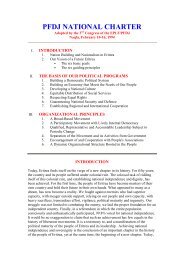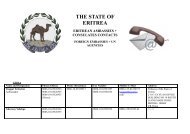Common Country Assessment (CCA) - ECSS | Eritrean Center for ...
Common Country Assessment (CCA) - ECSS | Eritrean Center for ...
Common Country Assessment (CCA) - ECSS | Eritrean Center for ...
Create successful ePaper yourself
Turn your PDF publications into a flip-book with our unique Google optimized e-Paper software.
Food Security (cont’d)<br />
Causality analysis<br />
• The root cause is low domestic production<br />
due to the prevailing semi-arid climate,<br />
characterized by erratic rainfall and frequent<br />
droughts: Eritrea is not likely to produce food<br />
in abundance, livestock farming and drinking<br />
water supplies are adversely effected.<br />
• War damage to agricultural infrastructure,<br />
machinery and inputs; loss of livestock;<br />
population displacement and dislocation,<br />
which disrupted farming activities; some<br />
farmlands remaining idle because of<br />
landmine infestation.<br />
• Predominance of low-productivity owing to<br />
subsistence farming, fragmented land<br />
ownership, poor farm management,<br />
de<strong>for</strong>estation and uncontrolled over-grazing<br />
contributing to water-table depletion.<br />
Capacity gaps and key challenges<br />
Management of water resources<br />
• Eritrea now depends overwhelmingly on rain-fed agriculture. More intensive<br />
production using irrigation is needed to promote commercial irrigated<br />
agriculture and increase yields. Foremost, this must be preceded by a careful<br />
assessment of the water resources of the country.<br />
Modernization of traditional agriculture<br />
• Reliance on traditional practices and crop varieties entails low production even<br />
in years of good rainfall.<br />
• A cautious but widespread dissemination of high-yielding crop varieties and<br />
modern inputs such as fertilizer and pesticides and adoption of improved<br />
storage practices are required.<br />
Shortage of labour<br />
• Even in years of good rainfall, the shortage of agricultural labour limits the area<br />
of land that households can cultivate.<br />
• Female-headed households are particularly hard hit by the labour shortage.<br />
Land tenure and fragmentation<br />
• Land holding, especially in the highlands and midlands (Anseba) is<br />
fragmented, and it discourages users to invest in soil conservation and tree<br />
planting improvements.<br />
Increasing production of high value crops<br />
• Eritrea has comparative advantages in the production and exportation of high<br />
value agricultural products.<br />
Operationalizing MDG 8 in support of national food security<br />
• A central feature of such a mobilization ef<strong>for</strong>t would be the articulation of a<br />
budgeted plan of action.<br />
Potential areas <strong>for</strong> UN system<br />
cooperation<br />
Capacity building to collect, analyze and disseminate<br />
national and household food security in<strong>for</strong>mation<br />
• Essential <strong>for</strong> policymaking and early action to<br />
avert hunger and famine.<br />
Diversification of opportunities <strong>for</strong> sustainable<br />
livelihoods in agriculture and fisheries<br />
• This should include assistance to pastoralists to<br />
create sustained increases in productivity without<br />
affecting their environment adversely.<br />
Land use planning<br />
• Assistance is required in the finalization and<br />
implementation of policies, strategies and laws<br />
related to land and land use planning, agriculture,<br />
<strong>for</strong>estry and fisheries.<br />
Water harvesting, management and soil conservation<br />
• Water and soil are the greatest assets <strong>for</strong> the poor<br />
in rural areas. Improved water harvesting and soil<br />
conservation are crucial <strong>for</strong> rural livelihoods.





